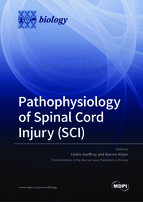Pathophysiology of Spinal Cord Injury (SCI)
A special issue of Biology (ISSN 2079-7737). This special issue belongs to the section "Medical Biology".
Deadline for manuscript submissions: closed (31 January 2022) | Viewed by 44750
Special Issue Editors
Interests: axon growth; regeneration; spinal cord injury
Special Issues, Collections and Topics in MDPI journals
Interests: spinal cord injury; neural control of breathing; plasticity; axonal regeneration and sprouting; personalized medicine
Special Issue Information
Dear Colleagues,
Spinal cord injury (SCI) leads to paralysis, sensory, and autonomic nervous system dysfunctions. However, the pathophysiology of SCI is complex, not limited to the nervous system. Indeed, several other organs and tissue are also affected by the injury, directly or not, acutely or chronically, which induces numerous health complications. While a lot of research has been performed to repair motor and sensory functions, SCI-induced health issues are less studied, although they represent a major concern among patients. There is a gap of knowledge in pre-clinical models studying these SCI-induced health complications that limits translational applications in humans.
In this Special Issue of Biology, we encourage the submission of manuscripts on any aspects of the pathophysiology of spinal cord injuries. This includes, but is not limited to, the impact of SCI on cardiovascular function, bladder and bowel function, risk of infections associated with SCI, liver pathology, metabolic syndrome, bones and muscles loss, and cognitive functions. We welcome original research articles, review articles, and short communications. This Special Issue will provide an overview of the pre-clinical models available to study the pathophysiology of SCI, and bring experts in the field to discuss what is needed to increase the research and translational potential of SCI-induced health complications.
Dr. Cédric G. Geoffroy
Dr. Warren Alilain
Guest Editors
Manuscript Submission Information
Manuscripts should be submitted online at www.mdpi.com by registering and logging in to this website. Once you are registered, click here to go to the submission form. Manuscripts can be submitted until the deadline. All submissions that pass pre-check are peer-reviewed. Accepted papers will be published continuously in the journal (as soon as accepted) and will be listed together on the special issue website. Research articles, review articles as well as short communications are invited. For planned papers, a title and short abstract (about 100 words) can be sent to the Editorial Office for announcement on this website.
Submitted manuscripts should not have been published previously, nor be under consideration for publication elsewhere (except conference proceedings papers). All manuscripts are thoroughly refereed through a single-blind peer-review process. A guide for authors and other relevant information for submission of manuscripts is available on the Instructions for Authors page. Biology is an international peer-reviewed open access monthly journal published by MDPI.
Please visit the Instructions for Authors page before submitting a manuscript. The Article Processing Charge (APC) for publication in this open access journal is 2700 CHF (Swiss Francs). Submitted papers should be well formatted and use good English. Authors may use MDPI's English editing service prior to publication or during author revisions.
Keywords
- spinal cord injury
- cardiovascular function
- bladder function
- bowel function
- infections
- liver pathology
- metabolic syndrome
- bone loss
- muscle loss
- cognitive functions
- sexual functions








